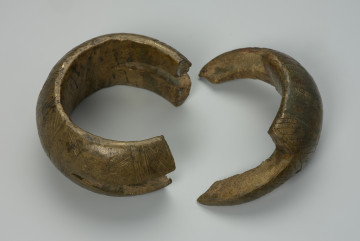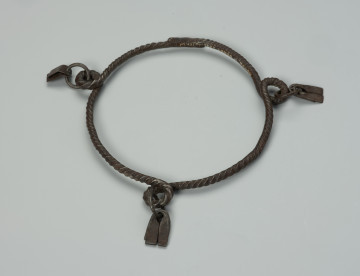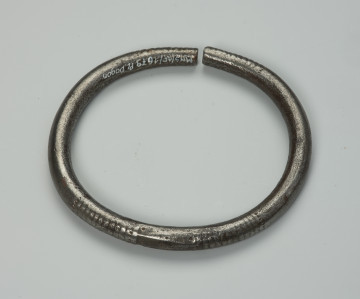
Women's anklet
między 1940 — 1950
National Museum in Szczecin
Part of the collection: Collection of Dogonian art
The sickle forged from iron, with a wooden handle ending in a carved ancestral head, was made by a blacksmith. The Dogon distinguish between dyemmen - blacksmiths descended from the caste (by birth) and irin - those descended from the farming community (apprenticeship). Both groups are equally respected, have the same privileges and lead a similar lifestyle. Blacksmiths are primarily engaged in making tools - hoes, sickles, axes and knives. They also make spearheads, swords, bells, ornaments and razors. They are also considered ‘masters of wood’. They make doors, shutters and wooden vessels and carve figures representing ancestors and decorative locks for doors. They live in separate districts, which are usually located on the outskirts of villages. The smithy is located outside the house. Its most important element is the hearth. Equally essential items of equipment in the forge are the bellows, anvil, pincers and hammer. The bellows have two clay chambers that resemble pots covered with goatskin. The anvil is a block of iron in the shape of a truncated pyramid. Sometimes it is a massive stone placed on the ground. The anvil symbolises the womb of a woman. The hammer is the symbol of the water spirit. The pincers, on the other hand, are considered a relatively new attribute of the blacksmith. The Dogon believe that before the arrival of pincers blacksmiths used to hold heated iron in their hands. To commemorate these times, a symbolic dance takes place during the funeral of a blacksmith, which involves passing a hot piece of iron from hand to hand. At the end of the 20th century, agriculture also became an additional source of income for blacksmiths. In tourist areas, blacksmiths also make souvenirs.
Katarzyna Findlik-Gawron
Author / creator
Dimensions
cały obiekt: height: 34,3 cm, width: 17,5 cm
Object type
agricultural equipment
Creation time / dating
Creation / finding place
Identification number
Location / status

między 1940 — 1950
National Museum in Szczecin

około 1940
National Museum in Szczecin

około 1940
National Museum in Szczecin
DISCOVER this TOPIC
National Museum in Lublin
DISCOVER this PATH
Educational path